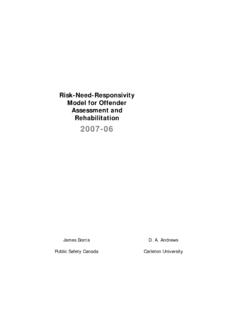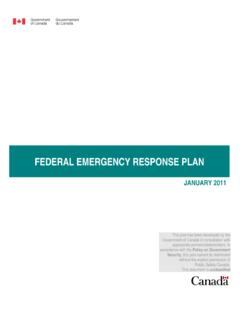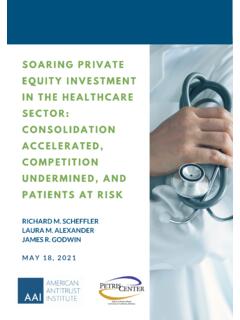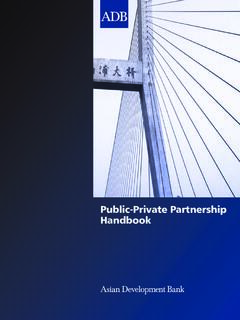Transcription of The Use of Private Security Services for Policing
1 The Use of Private Security Services for Policing by Ruth Montgomery and Curt Taylor Griffiths RESEARCH REPORT: 2015 R041 RESEARCH DIVISION THE USE OF Private Security IN Policing public SAFETY CANADA 2 Abstract This paper examines the intersections between Private Security and public Policing , with an emphasis on those functions that Private Security are now performing that have traditionally been performed by the public police, as well as cooperative efforts between public police and Private Security . The research included a literature review of the roles, responsibilities of Private and public Policing in the United Kingdom, the United States of America, Australia, New Zealand and Canada, a review of relevant Canadian legislation, and interviews with key individuals in Canadian government, Private Security , Policing , and police governance organizations.
2 Author s Note The views expressed are those of the authors and do not necessarily reflect those of public Safety Canada. Correspondence concerning this report should be addressed to: Research Division public Safety Canada 340 Laurier Avenue West Ottawa, Ontario K1A 0P8 Email: Acknowledgements The project team would like to thank those individuals who were interviewed for the study. Their candid and insightful observations on the state of Private Security in Canada comprise a core component of this report. Product Information Her Majesty the Queen in Right of Canada, 2016 Cat. PS113-1/2015-45E-PDF ISBN Number: 978-0-660-03495-9 THE USE OF Private Security IN Policing public SAFETY CANADA 3 Table of Contents The Transformation of Policing and Growth of Private Industry.
3 6 Core Policing .. 6 The Growth of the Private Security Industry .. 7 Types of Private Security .. 8 The Police and Private Security Environment .. 9 Private Security and the Economics and Sustainability of Policing .. 9 Policing and the Costs of Crime .. 11 Outsourcing vs. public Police- Private Security Partnerships .. 12 Differences between public Police and Private Security .. 13 The Role and Powers of Private Security Officers .. 15 Obstacles to the Development of public Police- Private Security Partnerships .. 15 Opportunities for public Police- Private Security Partnerships .. 16 Private Security , Democratic Values, and the public Good .. 18 Privatization, Private Security and the Community.
4 19 Oversight and Accountability of Private 21 The Effectiveness of Private Security .. 22 Training and Skill Levels of Private Security Personnel .. 23 The Limits of Private Security .. 24 Private Security and Privatization .. 25 The United States .. 25 Types of Private Security .. 27 public Police- Private Security 27 Training, Licensing and Certification .. 28 Australia .. 29 Training, Licensing and Regulation .. 29 The Activities of Private Security .. 31 public Police- Private Security 31 Concerns Surrounding Private Security .. 32 The Effectiveness of Australian public Police- Private Security Partnerships .. 33 New Zealand .. 33 United Kingdom .. 34 THE USE OF Private Security IN Policing public SAFETY CANADA 4 public Police- Private Security 34 Selected Examples of public Police- Private Security Partnerships.
5 35 The Impact of Privatization and the Increased Role of Private Security .. 36 The Lincolnshire Police-G4S Partnership .. 37 The Effectiveness of Privatization .. 38 Privatization and Partnerships: Lessons Learned .. 39 Canada .. 40 The Continuum of Canadian 41 The Economics of Policing and Private Security .. 42 Private Security Functions .. 43 public Police- Private Security Collaboration .. 45 Police Resistance to Private Security .. 46 Montreal Airport Policing .. 46 University of Waterloo Police .. 47 Canadian Private Security Legislation by Jurisdiction .. 48 Licensing Authority .. 48 Government Accountability .. 49 Security Services Licensing .. 49 Licensing Requirements for Individuals and Agencies.
6 50 Training .. 51 Mandated Training for Specialized Licenses .. 51 Legislated Conduct Requirements .. 52 Complaint and Appeal Management .. 52 Licensee Reporting Requirements .. 53 Uniform, Vehicle, Equipment and Service Dog Regulations .. 54 Prohibited and Restricted Equipment .. 55 Use of Dogs .. 55 Review of Legislative and Policy Guidelines for Private Security .. 55 Governance, and Government Perspectives on Private Security .. 56 Recruitment and Training .. 58 Community Engagement .. 58 Legislative and Regulatory Framework .. 58 Collaboration .. 59 Oversight and Accountability .. 59 THE USE OF Private Security IN Policing public SAFETY CANADA 5 Organized Crime.
7 60 Areas for Policy 60 Determining the Potential of Private Security .. 60 Oversight and Accountability .. 61 Contracting and Performance Assessment .. 61 The Community .. 61 Information for Decision Makers .. 61 public - Private Partnerships .. 61 Areas for Further Research .. 62 Key Considerations .. 63 The Effectiveness of Private Security .. 63 Implementing Effective Police- Private Security Partnerships .. 63 Defining the Core Functions of the public Police .. 63 The Impact of Privatization on the Numbers of public Police .. 63 Ensuring Effective Oversight of Private Security .. 64 The Role and Activities of Corporate Security Units .. 64 The Role of Police Unions and Associations.
8 64 Measuring the Cost Effectiveness of Police- Private Security Initiatives .. 64 public Police- Private Security Partnerships versus Privatization and Outsourcing .. 65 Research on Private Security Activities .. 65 Developing Standards and Accreditation .. 65 Next Steps .. 65 Acronyms .. 67 References .. 68 Appendices .. 82 Appendix A Persons Performing Police Functions .. 83 Appendix B Selected tables .. 84 Appendix C Interview schedule .. 97 Appendix D Canadian Police Acts and Private Security Legislation .. 99 THE USE OF Private Security IN Policing public SAFETY CANADA 6 The Transformation of Policing and Growth of Private Industry Core Policing Core Policing in the early 21st century is most accurately characterized as quality of life Policing , which promotes healthy communities.
9 It is the type of Policing that requires officers to have a multi-faceted skill set and to respond to a variety of order maintenance, service demands, and community expectations. Its other attributes include (Griffiths, 2016): developing and sustaining partnerships with the community; taking initiatives to improve the quality of life in communities and neighborhoods; providing reassurance to community residents and reducing the fear of crime; conducting outreach to newcomer groups, Aboriginal peoples, and vulnerable groups; engaging in collaborative partnerships with agencies and organizations, including operating specialized patrol units; and increasing the use of statistical analysis to ensure that resources are deployed effectively and efficiently.
10 The broadening of the police role occurred with the adoption of the community- Policing model in the 1980s and this role has continued to expand beyond a singular focus on law enforcement. This has also been driven by political and public expectations, legislation, and policy (Griffiths, 2016). The increased demands placed on police Services are often the result of downloading that involves the police becoming involved in events and with persons that fall within the mandate of other municipal and provincial agencies. This includes the demands that are placed on the police in encounters with persons with a mental illness (PwMI) and police responsibility for marginalized persons.










